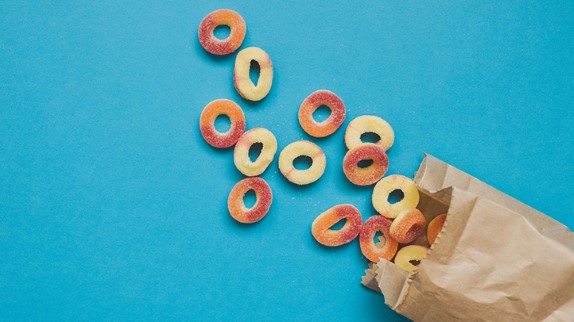Does your little sweetie have a big taste for sweets? If so, you might be tempted to think that his adorable penchant for all things sugary is really no big deal. After all, how could a piece of birthday cake be a bad thing? Or those cookies at playgroup? Or the cupcakes from Grandma?
And sure — a sweet treat every now and then isn’t terrible in the grand scheme of things, but if your child has a sugar-powdered grin every time you spy him in the kitchen — or if you find yourself wrestling treats away from him more often than not, you may want to consider ways to tame your tot's sweet tooth.
Here are a few ways you can limit sugar in your toddler’s diet.
How much sugar should children eat?
Tots aged 2 and older should limit their added — or “extra” — sugar intake to 25 grams, or about 6 teaspoons, a day.
Added sugar refers to the sugar or syrups that have been added into foods or drinks during the processing stages, as opposed to the natural sugars that are found in foods like milk (lactose) or fruit and vegetables (fructose). Foods that have natural sugar in them also contain nutrients such as protein and other vitamins and minerals that children need to grow.
In the U.S., however, many kids are consuming too much sweet stuff. Reports show that children get about 17 percent of their calories from added sugar — and about half of that comes from sugary drinks.
Health effects of sugar in children
The more sugary drinks, cake, candy and cookies your little cookie eats, the less room he’ll have in his tummy for nutritious foods that are essential for his growth. In fact, when it comes to kids and sugar, research shows that when children eat more sweets, they eat less produce, grains and dairy.
Recommended Reading
Not only does this mean they miss out on key nutrients, this also puts them at risk for poor bone density, higher LDL (“bad”) cholesterol levels, obesity and type 2 diabetes.
And of course, sugary foods don’t exactly make your child’s pearly whites any whiter. Excess sugar in young children’s diets is thought to be one of the reasons that 23 percent of 2- to 5-year-olds have cavities in their baby teeth.
How to limit your child's sugar intake
Skip sugary drinks
About half of the added sugar in children’s diets come from sugar-sweetened beverages (soda, fruit punches and sports drinks). These drinks are one of the biggest sources of refined sugar and empty calories in a child’s diet — and a major factor in childhood obesity. Instead, serve him water, cow’s milk or soy milk.
What about fruit juice? If you serve it, stick with 100 percent juice, and keep it to no more than 4 ounces a day for 1- to 3-year-olds, or 4 to 6 ounces for children ages 4 to 6. Try, too, to avoid letting your little one tote a sippy cup of juice around with him all day.
You can also cut the sugar in fruit juice by serving up juice that has been diluted with water. A better idea: Sweeten plain water with slices of fruit.
Don’t use sweets as a reward
It’s tempting to offer your little one a treat for all of his many accomplishments, but in the long run, this might just cause him to expect a sugary snack for every job well done.
Likewise, you don’t have to serve up sweets for every special occasion. Instead of offering cupcakes or cake for every holiday or event, try preparing fruits or vegetables in fun, festive-ways — a bowl of oatmeal with a snowman’s face or a “reindeer” pancake with a strawberry for a nose.
Avoid linking candy to comfort
When your child gets upset, don’t automatically reach for his favorite candy to cheer him up. This could set up an unhealthy relationship between emotions and high-calorie foods.
When your child needs a boost, offer kisses. When your toddler picks up his toys or uses the potty, reward him with a sticker or a cuddle, not candy. Really, what could be sweeter than your loving hugs?
Satisfy his sweet tooth with healthy fare
Give your tot the sweet taste he craves in the form of healthier desserts, like sliced fruit with yogurt. That way, he’ll satisfy his sweet tooth and his nutrition needs. Other healthy sweet treats: fruit smoothies and homemade frozen-fruit juice pops.
Don’t ban sweets
This can backfire big time. As any frequent dieter knows, you always want what you can’t have — and usually, you want it more than ever before! The same goes for young children. Forbid sugar completely, and you may create a sweets-starved tot who binges on candy whenever he gets the chance.
So don’t deprive him completely. Let him have some high-octane sweets — in tot-sized portions — on special occasions.
Sneaky sugar sources to avoid when feeding your child
Many toddler snacks — even some of those that claim to be nutritious — contain added sugars. How you can tell which ones have been sweetened? By reading the food label on the side of the box instead of the words on the front.
All ingredients in a product are listed on the label in order of their predominance, with the first ingredient the most plentiful, and the last the least. So a “nutritious” fruit bar that list its first three ingredients as “sugar, high fructose corn syrup and fruit juice concentrate” clearly has a lot more sugar than it does fruit.
Keep in mind that sugar goes by many other names, so be on the lookout for these terms:
- High-fructose corn syrup
- Fruit-juice concentrate
- Lactose
- Maltose
- Sucrose
- Glucose
- Dextrose
- Evaporated cane juice
- Molasses
- Barley malt
- Diastatic malt
- Ethyl maltol
- Maltodextrin
- Honey





 Trending On What to Expect
Trending On What to Expect






